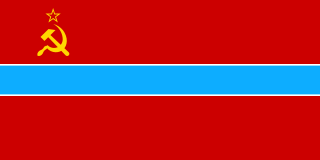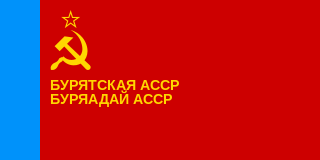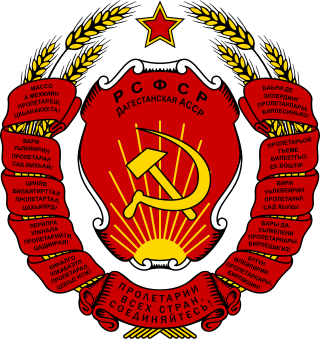
The last Soviet Union (USSR)-era flag was adopted by the Russian SFSR in 1954 and used until 1991. The flag of the Russian SFSR was a defacement of the flag of the Soviet Union. The constitution stipulated:
The state flag of the Russian Soviet Federative Socialist Republic (SFSR) presents itself as a red, rectangular sheet with a light-blue stripe at the pole extending all the width [read height] which constitutes one eighth length of the flag.

The Uzbek Soviet Socialist Republic, also known as Soviet Uzbekistan, the Uzbek SSR, UzSSR, or simply Uzbekistan and rarely Uzbekia, was a union republic of the Soviet Union. It was governed by the Uzbek branch of the Soviet Communist Party, the legal political party, from 1925 until 1990. From 1990 to 1991, it was a sovereign part of the Soviet Union with its own legislation.
An Autonomous Soviet Socialist Republic was a type of administrative unit in the Soviet Union (USSR) created for certain nations. The ASSRs had a status lower than the constituent union republics of the USSR, but higher than the autonomous oblasts and the autonomous okrugs.
Abkhazia is a region in the Caucasus that is under the effective control of the partially recognised self-declared Republic of Abkhazia. The de jure majority internationally recognized Autonomous Republic of Abkhazia claims to be its legitimate government.

The Checheno-Ingush Autonomous Soviet Socialist Republic, abbreviated as the Checheno-Ingush ASSR, was an autonomous republic within the Russian Soviet Federative Socialist Republic, in existence from 1936 to 1944 and again from 1957 to 1992. Its capital was Grozny. The 1979 census reported the territory had an area of 19,300 square kilometres (7,500 sq mi) and a population of 1,155,805 : 611,405 being Chechens, 134,744 Ingush, and the rest being Russians and other ethnic groups.

The Buryat Autonomous Soviet Socialist Republic, abbreviated as Buryat ASSR, was an autonomous republic of the Russian SFSR within the Soviet Union.

The Tuvan Autonomous Soviet Socialist Republic, or the Tuvan ASSR, was an autonomous republic of the Russian SFSR. It was created on 10 October 1961 from the Tuvan Autonomous Oblast. Its territory measured 175,000 square kilometers and bordered Mongolia to the south, Buryat ASSR to the east, Gorno-Altai Autonomous Oblast to the west and Khakas Autonomous Oblast to the north.

The Mari Autonomous Soviet Socialist Republic was an autonomous republic of the Russian SFSR, succeeding the Mari Autonomous Oblast. When the Soviet Union disintegrated, the Mari ASSR became the Mari El Republic, a federal subject of the Russian Federation.

The Kazakh Autonomous Socialist Soviet Republic, abbreviated as Kazak ASSR and simply Kazakhstan, was an autonomous republic of the Russian Soviet Federative Socialist Republic (RSFSR) within the Soviet Union which existed from 1920 until 1936.

The flag of the Republic of Sakha (Yakutia) (Yakut: Саха Өрөспүүбүлүкэтин былааҕа Saqa Öröspüübülüketin Bılaağa; Russian: Флаг Республики Саха (Якутия)), in the Russian Federation, is one of the official symbols of the Sakha Republic, alongside the coat of arms and the national anthem of the Sakha Republic. The flag has four horizontal stripes. From top to bottom, the stripes are light blue (3/4 of the flag's width), white (1/16), red (1/16), and green (1/8). The flag has been used officially as the flag of the Sakha Republic since 14 October 1992. The light blue stripe is charged with a white disc in the center. The diameter of the disc is 2/5 of the flag's width.

The Dagestan Autonomous Soviet Socialist Republic (1921–1991), abbreviated as Dagestan ASSR or DASSR and also unofficially known as Soviet Dagestan or just simply Dagestan, was an autonomous republic of the Russian SFSR within the Soviet Union. This "Land of Mountains" was known also for having a "mountain of peoples," with more than thirty ethnic groups indigenous to the territory. This region was absorbed in to the Russian empire in 1813 after the signing of the Gulistan Peace Treaty, and subsequently became a breeding ground for early revolutionary fervor in the Russian Revolution due its people's discontent with being part of the empire.
Cantons were administrative units in several autonomous republics and regions of Russian Soviet Federative Socialist Republic, and then the Soviet Union, in 1919–1941. Cantons existed in Bashkir ASSR (1919–1930), Dagestan ASSR (1928–1929), Kirghiz ASSR (1926–1930), Tatar ASSR (1920–1930), Mariyskaya AO (1921–1932) and the Volga German ASSR (1922–1941).

The flag of the Republic of Dagestan was adopted after the transformation of the Dagestan ASSR into the Republic of Dagestan within the Russian Federation. The flag was formally adopted on 26 February 1994. It features a horizontal tricolor of green, blue, and red. On 19 November 2003 the proportion of the flag was changed from the original 1:2 to 2:3, and the middle stripe from light blue to blue.

The Russian Soviet Federative Socialist Republic, previously known as the Russian Soviet Republic, and the Russian Socialist Federative Soviet Republic, as well as being unofficially referred to as Soviet Russia, the Russian Federation, or simply Russia, was an independent federal socialist state from 1917 to 1922, and afterwards the largest and most populous Soviet socialist republic of the Soviet Union (USSR) from 1922 to 1991, until becoming a sovereign part of the Soviet Union with priority of Russian laws over Union-level legislation in 1990 and 1991, the last two years of the existence of the USSR. The Russian SFSR was composed of sixteen smaller constituent units of autonomous republics, five autonomous oblasts, ten autonomous okrugs, six krais and forty oblasts. Russians formed the largest ethnic group. The capital of the Russian SFSR and the USSR as a whole was Moscow and the other major urban centers included Leningrad, Stalingrad, Novosibirsk, Sverdlovsk, Gorky and Kuybyshev. It was the first Marxist-Leninist state in the world.

The Kabardino-Balkarian Autonomous Soviet Socialist Republic was an autonomous republic of the Russian Soviet Federative Socialist Republic within the Soviet Union, and was originally a part of the Mountain Autonomous Soviet Socialist Republic. On 16 January 1922 the region was detached from the Mountain ASSR and the Kabardino-Balkarian Autonomous Oblast on 1 September 1921. It became an autonomous republic on 5 December 1936. On 30 January 1991, the Kabardino-Balkarian ASSR declared state sovereignty. It is now the Kabardino-Balkaria republic, a federal subject of the Russian Federation. The Kabardino-Balkarian ASSR bordered no other sovereign states during the existence of the Soviet Union.
The First Secretary of the Dagestan regional branch of the Communist Party of the Soviet Union was the position of highest authority in the Dagestan ASSR in the Russian SFSR of the Soviet Union. The position was created on February 16, 1919, and abolished in August 1991. The First Secretary was a de facto appointed position usually by the Politburo or the General Secretary himself.

The national emblem of the Checheno-Ingush Autonomous Soviet Socialist Republic was adopted in 1937 by the government of the Checheno-Ingush Autonomous Soviet Socialist Republic. The emblem is identical to the emblem of the Russian Soviet Federative Socialist Republic.

The national emblem of the Dagestan Autonomous Soviet Socialist Republic was adopted in 1937 by the government of the Dagestan Autonomous Soviet Socialist Republic. The emblem is identical to the emblem of the Russian Soviet Federative Socialist Republic.

The Khasavyurtovsky okrug was a district (okrug) of the Terek Oblast of the Caucasus Viceroyalty of the Russian Empire. The area of the Khasavyurtovsky okrug made up part of the North Caucasian Federal District of Russia. The district was eponymously named for its administrative centre, Khasavyurt.




















